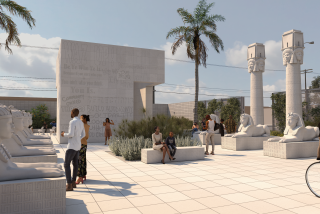WWII Memorial Design Accepted, Despite Critics
- Share via
WASHINGTON — The Fine Arts Commission unanimously approved a controversial design Thursday for the proposed World War II memorial and reaffirmed its support for a prominent site between the Washington Monument and the Lincoln Memorial.
The five hours of testimony and the unusually large crowd in attendance reflected the attention brought on the proposed monument by the National Coalition to Save Our Mall. While failing to change the vote of any of the seven commissioners, the group placed a spotlight on the usually quiet and deliberative process of selecting a national memorial site.
The design now goes before the National Capital Planning Commission, which is expected to approve it at its Sept. 7 meeting. The location for the memorial was approved in 1995, and officials from both commissions have said only an act of Congress could overturn the site selection, an event considered unlikely.
“I feel like my grandfather, the preacher, who only filled the church on Christmas,” said Commission Chairman J. Carter Brown as he ended the all-day meeting. “We love people to come to our meetings. We make decisions every four weeks that affect all of us.”
It was at a sparsely attended meeting five years ago that the commission moved from considering a site favored by the American Battle Monuments Commission, the memorial builder, to one that had never been on a potential site list, the Rainbow Pool. The little-known pool in the middle of the Mall lies just east of the larger, more familiar Reflecting Pool that mirrors the Lincoln Memorial.
The site became better known in 1997, when architect Friedrich St. Florian presented his first design proposal. His initial conception, so large that it obscured the view of the Lincoln Memorial, was rejected.
Thereafter, a few would testify against the site at each hearing when the World War II memorial was discussed, and were politely ignored. Thursday was different. There were more witnesses opposed to the site or the design or the process than those in support.
Architect Robert Miller denounced the site and design, saying, “The Mall is about to become a gated community.”
Veteran John Graves told the commission that “the project is well-greased” and that his small group, World War II Veterans to Save the Mall, didn’t have a chance because it couldn’t afford full-page newspaper ads and the endorsements of movie stars to lobby for its cause.
The first part of the meeting was taken up with testimony from supporters of the project, including Rep. Marcy Kaptur (D-Ohio), who sponsored the legislation to create the memorial, Sen. Daniel K. Inouye (D-Hawaii), Rep. Robert A. Weygand (D-R.I.) and former Sen. Bob Dole, who is finance chairman for the memorial and a World War II veteran.
Dole said $95 million of the estimated $100 million needed to build the monument has been raised.
The supporters all embraced St. Florian’s latest design, one that he refined from a concept the commission had approved in 1998.
The low-slung design calls for the land to be excavated so that most of the memorial is 6 feet below the current level of the Rainbow Pool. Set back into the tree line is a circle of columns and two arches.
More to Read
The biggest entertainment stories
Get our big stories about Hollywood, film, television, music, arts, culture and more right in your inbox as soon as they publish.
You may occasionally receive promotional content from the Los Angeles Times.










